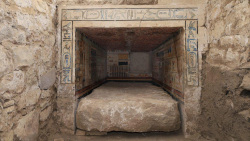
Chemicals in drip water form records of ancient fires in speleothem cave structures
Jay Alder/Oregon State University
In the event of a wildfire, flee into the cave. This is the official emergency policy of Oregon Caves National Monument and Preserve, a forested area protecting a labyrinth of passages dissolved in a rare marble formation high in the Siskiyou mountains. There hasn’t been a fire in the preserve for a century. But the potential for a conflagration in the dry forest is palpable. If a fast-moving wildfire were to burn through, the cave would be the safest place for park rangers to hide.
However, the 1.7-million-year-old cave is not entirely isolated from any fires burning on the surface. When a fire burns above, heat and smoke can alter the chemistry of the water that seeps down through the rock. As it drips into the cave, it can leave behind traces of fire in sheer layers of mineral residue. Over millennia, this builds up within weird cave structures known as speleothems, which protrude from every surface where water flows, including stalagmites on the cave floor and stalactites on the ceiling.
“It’s a snapshot,” Katie Wendt, a palaeoclimatologist at Oregon State University, told me when I joined her on a recent expedition into the cave. She is among a growing set of researchers using cave records of wildfires to extend our view of fire activity back hundreds of thousands of years, to a time when temperatures on Earth were even hotter than today. That, in turn,…








Leave a Comment